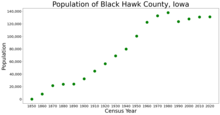Black Hawk County is a county in the northeastern part of U.S. state of Iowa. As of the 2020 census, the population was 131,144,[1] making it Iowa's fifth-most populous county. The county seat is Waterloo.[2]
Black Hawk County is part of the Waterloo – Cedar Falls metropolitan area.[3]
Black Hawk County was formed on February 17, 1853, from sections of Buchanan County. It was named after Black Hawk, a Sauk leader during the 1832 Black Hawk War.[4]
According to the U.S. Census Bureau, the county has an area of 573 square miles (1,480 km2), of which 566 square miles (1,470 km2) is land and 6.9 square miles (18 km2) (1.2%) is water.[5]
The Cedar River roughly divides the county in half from the northwest to the southeast corner. The land is mostly level since much of it is on the river's flood plain.

The 2020 census recorded a population of 131,144 in the county, with a population density of 229.5011/sq mi (88.6109/km2). 94.55% of the population reported being of one race. 73.49% were White, 10.43% were Black, 4.92% were Hispanic, 0.32% were Native American, 2.61% were Asian, 0.65% were Native Hawaiian or Pacific Islander and 7.57% were some other race or more than one race. There were 58,559 housing units of which 54,223 were occupied.[1]
The 2010 census recorded a population of 131,090 in the county, with a population density of 231.20/sq mi (89.27/km2). There were 55,887 housing units, of which 52,470 were occupied.[12]

At the 2000 census there were 128,012 people, 49,683 households, and 31,946 families in the county. The population density was 226 inhabitants per square mile (87/km2). There were 51,759 housing units at an average density of 91 per square mile (35/km2). The racial makeup of the county was 88.42% White, 7.95% Black or African American, 0.18% Native American, 0.98% Asian, 0.04% Pacific Islander, 0.93% from other races, and 1.49% from two or more races. 1.84%.[13] were Hispanic or Latino of any race.
Of the 49,683 households 29.50% had children under the age of 18 living with them, 50.20% were married couples living together, 10.80% had a female householder with no husband present, and 35.70% were non-families. 27.10% of households were one person and 10.90% were one person aged 65 or older. The average household size was 2.45 and the average family size was 2.97.
Age spread: 23.10% under the age of 18, 15.70% from 18 to 24, 25.20% from 25 to 44, 22.00% from 45 to 64, and 14.00% 65 or older. The median age was 34 years. For every 100 females, there were 92.30 males. For every 100 females age 18 and over, there were 88.80 males.
The median household income was $37,266 and the median family income was $47,398. Males had a median income of $33,138 versus $23,394 for females. The per capita income for the county was $18,885. About 7.90% of families and 13.10% of the population were below the poverty line, including 14.40% of those under age 18 and 8.90% of those age 65 or over.
Black Hawk County is divided into seventeen townships:
The population ranking of the following table is based on the 2020 census of Black Hawk County.[1]
† county seat
Black Hawk County has been a Democratic stronghold in Iowa since the late 1980s. In presidential politics, it is one of the most Democratic counties in Iowa. As the state swung hard to the right in the 2010s and 2020s, Black Hawk County—as a major population center, in accordance with most other population centers nationwide—has remained staunchly Democratic. In 2016, however, Donald Trump became the first Republican since 1984 to hold the Democratic candidate's margin to under 10 percent, something he repeated in 2020 albeit with reduced margins.
42°28′08″N 92°18′19″W / 42.46889°N 92.30528°W / 42.46889; -92.30528